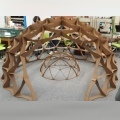
Geometry is used in architecture all the time
and domes are a wonderful visible example of the power of
mathematics. Domes are efficient in that they use only a
small amount of material to create something on an impressive
scale. They are familiar from common playground
structures. Young students especially love creating their
own spaces to play in, so building a dome is a natural way to
introduce a number of geometric ideas.
Here are a few dome construction workshops that culminate in a
large architectural space within the classroom. The first
is a paper model that anyone can do. The second is four
feet in diameter, using cardboard, which makes it easy to cut on
any kind of saw or laser-cutter. The third is over six
feet in diameter, using wood, so it is more permanent and can be
scaled larger.





